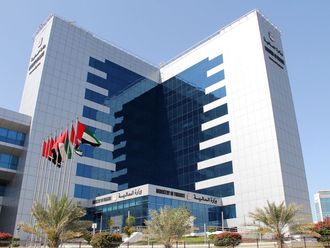
Dubai: Starting this week, the UAE’s banking sector will start reporting their annual results showing signs of strains on profitability and weakening asset quality as a result of the prolonged slump in oil prices and declining asset prices.
The third-quarter results reported by leading UAE banks had indications of a gradual slowdown in lending, profit growth and some signs of weakening credit quality.
While nine month figures show continued growth in earnings supported by both interest and non-interest income, a closer look at the quarterly performance points to challenges in the banking sector.
Markets are eagerly waiting for the numbers, especially in the context of a significant rise in non- performing loans expected from small and medium enterprises (SMEs) and some segments of retail business.
The SME sector, which witnessed rapid expansion supported by liberal bank funding in the post-financial crisis years, is finding the going tough as excess leverage and a difficult business environment are resulting in delays and/or defaults in loan repayments. Abdul Aziz Al Ghurair, Chairman of UAE Banks Federation, an association of 51 banks operating in the UAE said in November that the NPLs from SMEs could soar between Dh5 billion to Dh7 billion or about five per cent of total assets of UAE banks for the full year 2015.
After going through a period of strong asset growth in the post financial crisis year, weakness in SME portfolios of a number banks began to appear in late 2014 and 2015. Full year results for 2015 is expected to reveal the impact of impairments and outlook for the year ahead.
Results for the third quarter of 2015 showed moderation in profits. Emirates NBD (ENBD) reported a nine-month net profit of Dh5 billion, up 27 per cent year on year, but the bank’s third quarter profits showed a much more modest growth of 7 per cent year on year and a quarter on quarter growth of 2 per cent on second quarter.
National Bank of Abu Dhabi (NBAD) reported net profits of Dh1.32 billion in the third quarter of 2015, down 3 per cent year on year and 8 per cent sequentially. Net profits for the first nine months of 2015 were Dh4.19 billion, relatively flat compared to Dh4.2 billion reported in the same period in 2014.
Abu Dhabi-based First Gulf Bank (FGB) reported a group net profit of Dh4.29 billion for the first nine months of 2015, a 4 per cent increase compared to the same period last year. For FGB, third quarter net profit growth was flat at Dh1.42 billion compared to Dh1.43 billion in the third quarter of 2014.
Dubai headquartered Mashreq’s nine-month profits were up by a modest 5.1 per cent at Dh1.8 billion. Bankers admit the operating environment is challenging and the industry needs to adapt to the new economic conditions.
Results of some of the smaller banks showed deteriorating asset quality and a resurgence of higher impairment charges. Sharjah headquartered United Arab Bank (UAB) reported a net profit of Dh72 million for the first nine months of 2015, compared to Dh498 million for the same period of 2014. Net profit was impacted by higher provisioning.
Going forward, analysts expect lower earnings growth and higher credit losses likely for UAE banks due to the sharp oil price decline, resulting in weakening deposits, tighter liquidity, higher interest rates.
Global rating agency Standard & Poor’s expects declining profitability and deterioration in credit quality to linger on for the next 2 years.
“We are likely to see a gradual but longer deterioration in operating conditions for banks over the next several quarters or years. We believe the uncertainty about how long oil prices will remain weak will force businesses and government to adopt a conservative stance, which will weaken spending for infrastructure and private-sector investments, and rein in bank lending,” said Standard & Poor’s credit analyst Timucin Engin.
Currently the UAE banks are better regulated and have stronger underwriting practices, which make them less vulnerable to any sharp decline in asset quality.
Standard & Poor’s expects a slowdown in credit growth and continued weaker deposit growth, with a renewed but manageable deterioration in asset quality. All of these factors combined should result in negative earnings growth for the banks in 2016 and a lacklustre performance in 2017.
The rating agency maintains stable outlook for the UAE banks it rates. “We don’t see a big threat to capitalisation. The banks we rate continue to operate with strong capitalisation, with Tier 1 ratios generally above 15 per cent. However, from our discussions with banks, we believe that they will generally retain higher levels of earnings to ensure they have enough capital as credit losses increase. That means a cut in dividend payouts, which have been increasing over the past few years in line with profitability,” said Engin.












